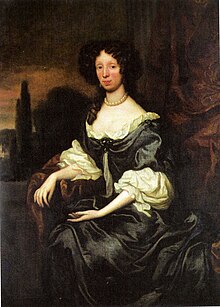Anne Hamilton, 3rd Duchess of Hamilton
| Anne Hamilton | |
|---|---|

The Duchess of Hamilton, by Sir Godfrey Kneller, Hamilton Collection, Lennoxlove
|
|
| Born |
6 January 1631 Palace of Whitehall, London |
| Died | 17 October 1716 (aged 85) Hamilton |
| Title | 3rd Duchess of Hamilton |
| Tenure | 1651–1698 |
| Other titles | Marchioness of Clydesdale Countess of Lanark Countess of Arran and Cambridge Lady of Aven and Innerdale |
| Nationality | Scottish |
| Residence | Hamilton Palace |
| Predecessor | William Hamilton, 2nd Duke of Hamilton |
| Successor | James Hamilton, 4th Duke of Hamilton |
| Spouse(s) | William Hamilton, Duke of Hamilton |
| Parents |
James Hamilton, 1st Duke of Hamilton Lady Mary Feilding |
Anne Hamilton, 3rd Duchess of Hamilton (6 January 1631 – 17 October 1716) was a Scottish peeress.
The daughter of Sir James Hamilton, 1st Duke of Hamilton and 3rd Marquess of Hamilton, Scottish General and premier peer of the realm, and Lady Mary Feilding, daughter of William Feilding, 1st Earl of Denbigh and Lady Susan Villiers, a sister of George Villiers, 1st Duke of Buckingham.
She was born at the Palace of Whitehall in London, where her mother was a Lady of the Bedchamber to Henrietta Maria of France, wife of King Charles I of Scotland and of England.
Following the 1st Duke's execution for his part in the Wars of the Three Kingdoms in 1649, his brother, William, Earl of Lanark, inherited the titles and lands. William died from wounds received at the Battle of Worcester in 1651, whilst leading his regiment into some of the thickest of the fighting. In his will made at the Hague in 1650, he stipulated that the Lady Anne was his heir, over and above his own children, (all daughters, his only son having died in childhood).
Lady Anne became the Duchess of Hamilton, with the subsidiary titles Marchioness of Clydesdale, Countess of Arran, Lanark and Cambridge, the Lady Aven, Innerdale, Machanshire and Polmont. She succeeded to the Dukedom of Hamilton thanks to a remainder that stipulated, the Dukedom should devolve upon his brother and male heirs, and that the eldest daughter of the 1st Duke should succeed to the Dukedom only if her uncle died leaving no sons.
...
Wikipedia
